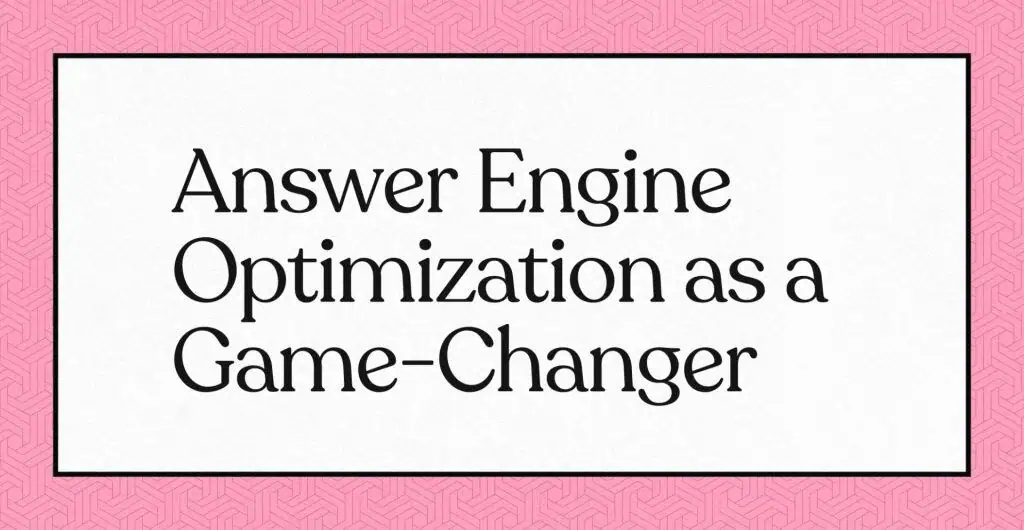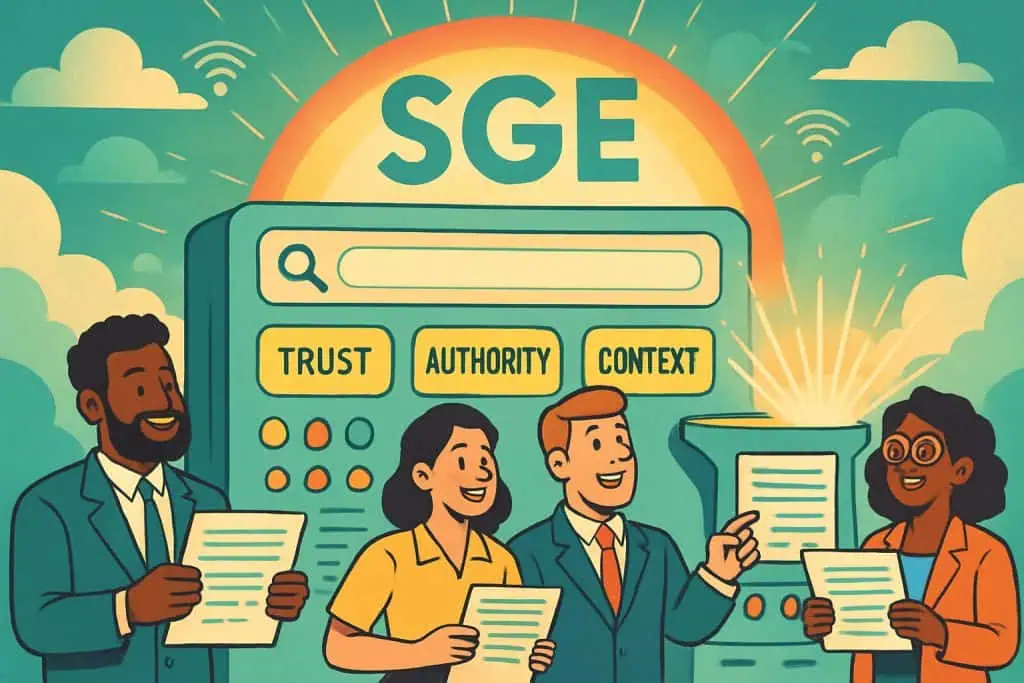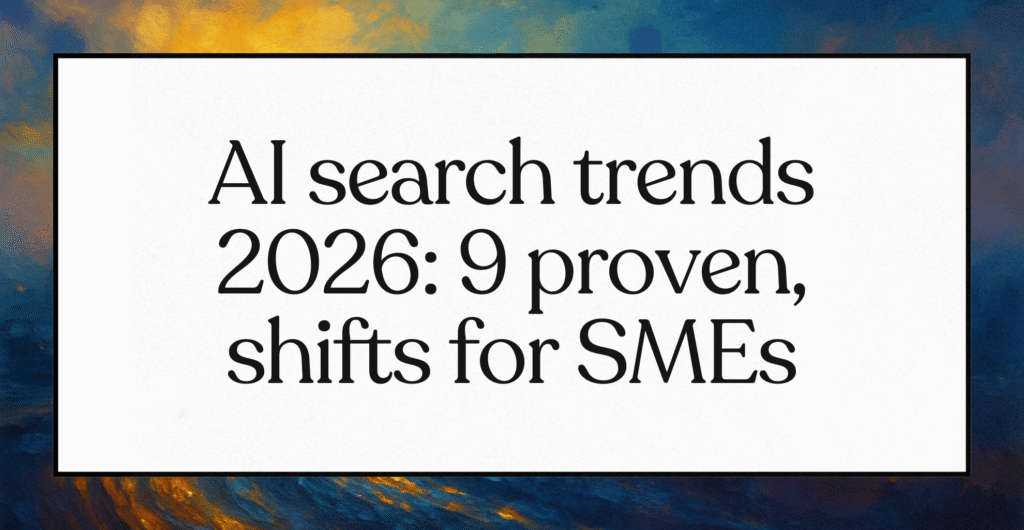Summary
Answer Engine Optimization in 2025 centers on earning citations inside AI answers from Google SGE, Bing Copilot, and assistants, where 65% of informational searches resolve and SGE appears on nearly 80% of complex queries. AEO prioritizes credibility, clarity, E-E-A-T, schema markup, semantic search, and NLP so content is extracted, cited, and trusted inside AI Overviews rather than merely ranked. Brands that master structured data, authoritative topic coverage, and snippet-ready formats retain visibility as answer engines outcompete traditional click-through SEO.
Last week, a Fortune 500 marketing executive watched traffic collapse by 42% overnight. The cause wasn’t a technical flaw or a penalty it was Google’s Search Generative Experience returning direct answers that bypassed traditional clicks. This is the reality marketers face as answer engines reshape how people consume information. The discipline that adapts to this shift is called Answer Engine Optimization.
Understanding Answer Engine Optimization in 2025
Traditional SEO was about improving rankings in search results. Answer Engine Optimization goes further. It aims to position content inside AI-driven responses where users get their answers without scrolling through lists of links. The priority is credibility, clarity, and authority qualities that determine whether your content gets quoted by Google SGE, Bing Copilot, or other conversational systems.
The rise of assistants like Siri, Alexa, and Google Assistant turned the spotlight on Answer Engine Optimization years ago, but in 2025 the practice has matured. Today, 65% of informational searches are resolved within answer engines. For complex queries, Google’s SGE banner appears almost 80% of the time. That means marketers who still focus solely on old SEO tactics risk invisibility.
The Technical Foundation of Answer Engines
Answer engines rely on frameworks that differ radically from traditional search. Large Language Models stitch information from multiple sites. Natural Language Processing enables conversational understanding. Neural matching ensures the right context is surfaced. Personalization determines which phrasing resonates with the user.
The Google SGE panel highlights this shift. It synthesizes text directly from indexed content and presents it as a ready-made answer. Next to the generated response, a carousel points to source material. That placement is where Answer Engine Optimization proves its worth: getting cited here equals visibility, authority, and trust.
Why Answer Engine Optimization Matters for Brands
A company that masters Answer Engine Optimization earns presence in the very answers people trust most. When AI systems resolve queries in seconds, the brand cited becomes the authority by default. That level of exposure influences not just search traffic but reputation and consumer confidence.
For publishers, the adjustment is uncomfortable. The old model rewarded long-tail traffic and steady click-through rates. With answer engines, the battlefield is narrower, and success depends on becoming the trusted source that algorithms draw from. Answer Engine Optimization is the discipline that makes this possible.
The shift toward answer-first systems will only intensify. Expect platforms to refine ranking criteria for trustworthiness and bias detection. Schema markup, structured data, and contextual authority will continue to shape how engines pull content. Teams that ignore Answer Engine Optimization risk losing organic reach in entire categories of queries.
By 2025, SEO without AEO is incomplete. Answer engines are the main gateway to knowledge. Brands that adapt will remain visible. Those that don’t will watch their presence fade. Answer Engine Optimization isn’t optional anymore; it’s survival.
How AEO Differs From Traditional SEO in 2025
The fundamental distinction between AEO and traditional SEO lies in their objectives, methodologies, and success metrics. These differences have become increasingly pronounced in 2025’s AI-dominant search scene.
Core Philosophical Differences
Traditional SEO has historically focused on optimizing algorithms to improve rankings in search results pages. Success is measured primarily through:
- Keyword rankings and position tracking
- Organic traffic volume
- Click-through rates
- Time on site and other engagement metrics
In contrast, AEO emphasizes creating authoritative content that resonates with users and builds trust. The goal shifts from appearing in search results to having your content featured directly in AI-generated answers. Success metrics include:
- Featured snippet and knowledge panel inclusion
- Source attribution in AI-generated responses
- Authority metrics like brand mention frequency
- Citation and reference rates across the web
Content Strategy Evolution with Answer Engine Optimization
Traditional SEO content strategies revolved around keyword placement. Writers built articles around target terms, hoping to capture clicks from search rankings. Answer Engine Optimization shifts that focus. The goal is providing the most trusted answer that an AI system will quote directly.
Effective Answer Engine Optimization demands more than keyword sprinkling. It requires content that fully addresses user questions with precision, authority, and depth. Clear explanations, concise wording, and fact-based detail make the difference between being chosen for an AI-generated response or ignored.
Authority also comes from demonstrating expertise. Answer engines pull from sources they consider reliable. That means Answer Engine Optimization strategies must highlight subject mastery, accuracy, and consistent sourcing.
Structure matters as well. Answer Engine Optimization favors content formatted for easy parsing: headings that map to questions, schema markup that clarifies meaning, and logical flow that AI systems can extract without confusion.
A key benefit of Answer Engine Optimization is resilience. While search algorithms evolve, AI-driven answer systems still reward clarity and credibility. Brands that build authority-based content can weather shifts in ranking formulas better than those relying on keyword hacks.
This adaptability means companies committed to Answer Engine Optimization gain stability in a volatile search environment. Instead of chasing every update, they maintain visibility because their material remains the most authoritative source to answer the query.
In 2025, the gap is widening: SEO gets you listed, but Answer Engine Optimization gets you cited.
AI’s Critical Role in Google SGE and Answer Engines
Artificial intelligence forms the foundation of modern answer engines, transforming how search queries are processed and answered. Understanding these AI systems is crucial for effective optimization.
Google’s Search Generative Experience harnesses AI to offer users a more organized search experience, modelling ChatGPT functionality within Google Search. When a user makes a query, an SGE banner appears above traditional results, unfolding AI-generated text that directly answers the question.
The impact on organic traffic can be substantial. With SGE, users no longer need to click through to websites since comprehensive answers are provided directly in search results. This means the SEO objective could shift to focusing solely on reaching the top three positions that feed the AI response, potentially diminishing the value of other rankings.
Key AI Models Driving Answer Engines
Several advanced AI models power today’s answer engines, each requiring specific optimization approaches:
BERT and Contextual Understanding
BERT (Bidirectional Encoder Representations from Transformers) helps Google understand the context of words in search queries by analyzing them concerning entire sentences. This means content must be written naturally and contextually relevant rather than keyword-stuffed.
RankBrain and Query Intent
RankBrain processes ambiguous queries using machine learning to interpret user intent. This system works alongside BERT to enhance understanding of what users seek, making intent-focused content essential for visibility.
Google’s Natural Language API
This system analyzes content for readability, sentiment, and entity recognition. Content creators can leverage this API to assess how search algorithms will interpret their text and adjust accordingly.
Gemini, PaLM2, and Generative AI
The latest generation of large language models, like Gemini, powers AI Overviews. These models use training from Google Shopping Graph and the indexed web to generate comprehensive answers. These models excel at synthesizing information from multiple sources, making it crucial to be identified as an authoritative source worthy of inclusion.
Most Effective AI Tools and Tactics for AEO Mastery
Implementing effective Answer Engine Optimization requires specialized tools and tactics designed specifically for the AI-driven search scene of 2025. Here are the most impactful approaches.
NLP Implementation for Content Strategy
Natural Language Processing has become central to AEO’s effective content strategy. By leveraging NLP, SEO specialists can optimize content for specific terms, contextual relevance, and user intent.
Practical NLP implementation strategies include:
- Focusing on intent-based keywords rather than volume-based keywords
- Creating comprehensive topic clusters instead of isolated pages
- Optimizing for conversational queries that match natural speech patterns
- Using Python-based NLP tools like spaCy or NLTK to analyze semantic relationships
An efficient approach involves keyword intent analysis, where NLP identifies whether queries are informational, navigational, or transactional, allowing content to be tailored accordingly.
Semantic Search Optimization Techniques
Semantic SEO focuses on optimizing content for user intent instead of keywords, improving relevance by understanding meaning and context. As advanced NLP models become standard in search engines, semantic optimization has become essential for AEO success.
Effective semantic optimization tactics include:
- Semantic keyword clustering: Grouping keywords based on contextual relationships allows content to be organized around topics rather than terms.
- Entity optimization: Identifying key entities (people, places, organizations, concepts) in your niche helps structure content to align with how search engines categorize information.
- Schema markup implementation: Using structured data helps answer engines understand content context and relationships, with FAQPage, HowTo, and Product schemas proving particularly valuable for AEO.
- Topic modelling: Creating comprehensive content that covers all aspects of a topic signals topical authority to answer engines.
AI-Generated Content Optimization
AI tools for content creation have evolved significantly, offering sophisticated options for developing AEO-friendly material.
The most effective tools include:
- ContentShake AI: Combines proprietary SEO data with AI to generate optimized content drafts and trending ideas.
- Semrush Copilot: Provides personalized recommendations and content optimization insights based on competitive analysis.
- Clearscope and SurferSEO: Offer advanced content optimization features that align with answer engine requirements by analyzing top-performing content.
- ChatGPT: When used with effective prompts, it is a versatile tool for content planning, outline creation, and title tag generation15.
When implementing AI-generated content , ensure human editorial oversight to maintain authenticity while benefiting from AI’s analytical capabilities.
Voice Search Optimization for AEO
Voice search represents a crucial component of the answer engine ecosystem, with over 157 million Americans now using voice search and 65.4% doing so regularly.
Voice search optimization requires specialized tactics:
- Research voice-specific keywords that reflect natural speech patterns
- Structure content in question-and-answer format
- Optimize for featured snippets, which often become voice search answers
- Ensure mobile optimization and fast load times
- Target local intent queries with location-specific information
Yext has emerged as one of the leading tools for voice search optimization, helping businesses structure their digital presence for voice queries.
Predictive Analytics for Strategic AEO
Predictive analytics employs data, statistical algorithms, and machine learning to identify future trends and content opportunities. This proactive approach allows AEO specialists to anticipate changes rather than merely reacting to them.
Key applications include:
- Keyword performance prediction: Forecasting future demand for keywords to optimize content strategy ahead of time
- Content impact forecasting: Analyzing historical performance to predict how new content might perform, allowing for strategic resource allocation
- User behaviour modelling: Predicting how users interact with content to optimize engagement strategies
Tools facilitating predictive analytics include Google Analytics 4, Semrush’s keyword forecasting features, and Ahrefs’ content explorer with trend analysis capabilities.
Implementing an Effective AEO Strategy: Step-by-Step Guide
Successfully implementing Answer Engine Optimization requires a systematic approach that builds upon SEO fundamentals while adapting to answer engine requirements.
1. Enhance E-E-A-T Signals
Experience, Expertise, Authoritativeness, and Trustworthiness (E-E-A-T) indicators significantly influence answer engine visibility. Studies show that improved E-E-A-T can trigger over 100% improvement in visibility. Strengthen these signals by:
- Including trust signals like certifications and credentials
- Supporting statements with credible citations
- Using an authoritative tone of voice
- Providing first-hand expertise and insights
- Highlighting author credentials and subject matter expertise
2. Structure Content for Answer Extraction
Answer engines need to easily extract information from your content. Implement these structural best practices:
- Create clear, concise paragraphs that directly answer specific questions
- Use descriptive headings and subheadings in a logical hierarchy
- Implement bulleted and numbered lists for processes and comparisons
- Include tables for comparative data
- Maintain an eighth-grade reading level for optimal comprehension
3. Leverage Comprehensive Structured Data
Structured data helps answer engines understand content context and relationships. Implement relevant schema markup types:
- FAQPage for question-and-answer content
- HowTo for instructional content
- Product markup for e-commerce items
- Organization and LocalBusiness for business information
- WebPage with speakable properties for voice search optimization
4. Develop Supporting Visual Assets
Visual elements provide alternative engagement opportunities and can appear in AI-generated results. Create:
- Infographics that illustrate complex concepts
- Diagrams that simplify processes
- Charts and graphs for data presentation
- Video content optimized with proper metadata
5. Implement Semantic Keyword Optimization
Move beyond traditional keyword targeting to semantic optimization:
- Research-related concepts and entities
- Create comprehensive content that covers all aspects of a topic
- Build internal linking structures that reinforce semantic relationships
- Use natural language that addresses user intent rather than keyword density
6. Optimize for Featured Snippets
Featured snippets often form the basis for answer engine responses. Target these valuable positions by:
- Directly answering common questions in concise paragraphs
- Using clear, definitive language
- Providing lists, tables, and step-by-step instructions
- Including relevant statistics and data points
7. Integrate Ethical AI Considerations
As AI becomes increasingly central to SEO, ethical implementation ensures sustainable success:
- Maintain transparency about AI usage in content creation
- Implement human oversight for AI-generated content
- Verify the accuracy of all AI-produced information
- Respect intellectual property rights when training or using AI tools
The Future of Answer Engine Optimization Beyond 2025
The trajectory of Answer Engine Optimization shows no signs of slowing down. As answer engines grow more advanced, new trends are reshaping how brands secure visibility inside AI-driven responses.
Generative Engine Optimization
Generative Engine Optimization (GEO) is emerging as a key layer within Answer Engine Optimization. It focuses on enhancing the likelihood that content will be cited in AI-generated answers through targeted black-box optimization techniques. Early experiments suggest that GEO can give publishers an edge by improving how their material is scored by generative systems. In practice, GEO is not a replacement but a subset of Answer Engine Optimization, built to handle the new demands of AI-first search.
Multimodal Search Integration
The future of Answer Engine Optimization is not limited to text. Answer engines are evolving to interpret and rank across modalities: voice queries, video snippets, image recognition, and even interactive content. For practitioners, this means preparing assets in multiple forms:
- Videos must include transcripts and structured metadata.
- Images require descriptive alt text and contextual framing.
- Podcasts and audio files should be transcribed and searchable.
- Interactive experiences need to deliver answers as cleanly as written articles.
By expanding scope in this way, Answer Engine Optimization becomes the framework that ensures authority across every medium.
AI Ethics and Transparency Requirements
Regulators and platforms alike are pressing for greater accountability in AI systems. For Answer Engine Optimization, this translates into aligning with transparency rules: clear disclosure of AI-generated sections, mitigation of algorithmic bias, and proper attribution of intellectual property. Brands that embed ethical practices into their Answer Engine Optimization processes will secure both compliance and trust.
The Convergence of SEO and AEO
Beyond 2025, Answer Engine Optimization and traditional SEO are likely to merge. Search platforms continue to reward authority, expertise, and user trust, regardless of whether the result is a link or a generated paragraph. Success will depend on hybrid strategies—technical SEO for crawlability, combined with Answer Engine Optimization for answer inclusion. The line between ranking and being cited will blur until both are inseparable.
Closing Perspective
Answer Engine Optimization has become the cornerstone of digital marketing strategy in 2025. Appearing in AI-generated responses now matters as much as, if not more than, classic ranking positions. The organizations that thrive will master structured data, semantic optimization, and NLP techniques while backing it all with authentic subject expertise.
The true aim of Answer Engine Optimization is authority. The future belongs to content creators whose work provides such clear and reliable answers that engines have no choice but to cite them.
Sources
Q&A
Q: What is Answer Engine Optimization and how does it differ from SEO in 2025?
A: AEO targets inclusion and citation inside AI answers, while traditional SEO targets rankings and clicks.
Q: How can brands optimize for Google SGE and AI Overviews?
A: Use concise answers, FAQ/HowTo schema, strong E-E-A-T, semantic clusters, and snippet-oriented structures.
Q: Which AI and NLP elements drive AEO success?
A: Contextual models like BERT, intent handling via RankBrain, entity-focused NLP, and structured data parsing.
Q: What forward-looking tactics strengthen AEO strategy?
A: GEO testing, multimodal assets with metadata, voice search optimization, and predictive analytics for topic demand.











